If you plan climbing Tofana di Rozes by following its normal route, here you have my first-hand report. I did it solo in the first week of July so this is a summer ascent report.
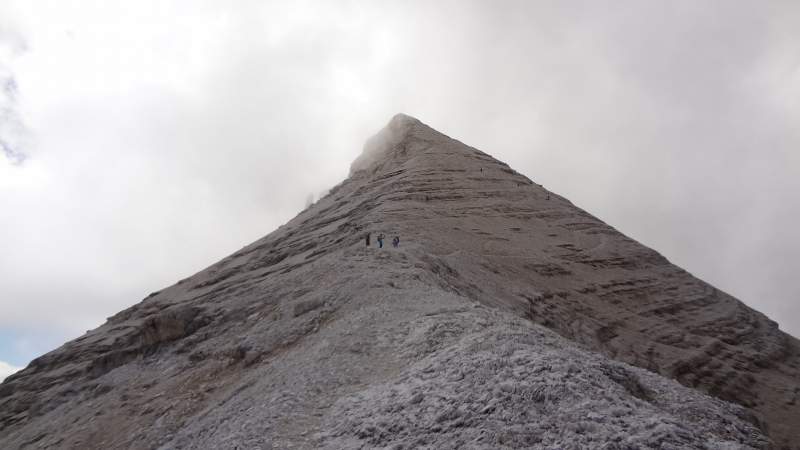
I would start from the end. Namely after climbing Tofana di Rozes, I was admiring the mountain from the Passo Falzarego (2117 m, 6945 ft), and it was a bit hard to believe that the same morning I was on its summit.
See how it looked from this already high view point, the summit is a bit in the clouds. The road that you see below goes to Cortina d’Ampezzo.
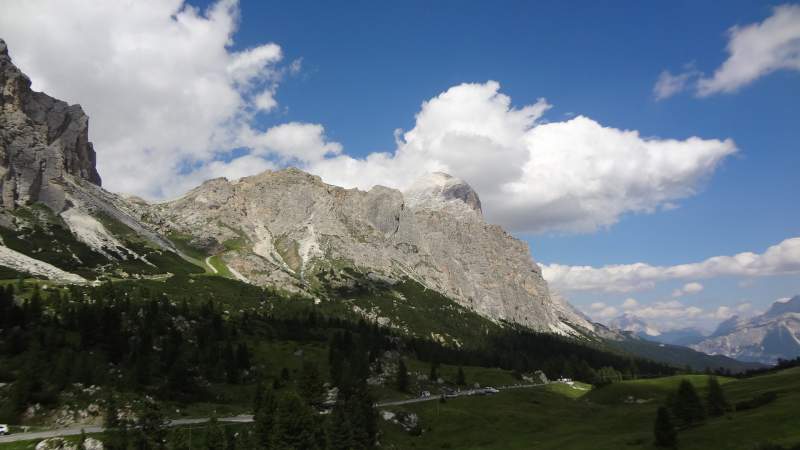
The mountain looks impressive from every side, and on a sunny day its summit looks white. But this is due to lots of lose rock and not because of snow, at least during the summer time.
Access roads & coordinates
Tofana di Rozes rises on the west side of Cortina d’Ampezzo and this is the closest town for supplies. The mountain belongs to the Dolomites, Province of Belluno, Veneto, Italy.
This is the most popular of the three peaks in the Tofane group, the other two are Tofana di Mezzo (3244 m, 10,643 ft), and Tofana di Dentro (3238 m, 10,623 ft). So if you want to enjoy the summit in solitude, it is best to go very early and definitely avoid weekends.
If you come from the direction of Cortina d’Ampezzo, it may be a bit tricky to get the road from the city. So follow the direction to Pocol and Falzarego pass. After Pocol, you will see the road to Dibona hut on the right. At this point you are still in the woods.
Note that this is a narrow asphalt road in the first part, but its last 4 kilometers are a macadam. It is not in the best state but many people are using it so you can do as well.
The AllTrails map below shows all the details. If you follow the link you will find more.
Tofana di Rozes numbers & details
- Coordinates, latitude & longitude: 46.53735° N; 12.05087° E.
- Elevation: 3225 m (10580 ft).
- Normal route difficulty: walk-up.
- Height difference to climb from the car parking: 1142 m (3746 ft).
- Time necessary to climb from the car camping: 4 – 5 hours, but this all depends on you.
- Useful map: Cortina d’Ampezzo e Dolomiti Ampezzane, Tabacco, 03, 1:25000.
- Places to sleep: Angelo Dibona hut, Camillo Giussani hut.
The routes
There are two main normal routes to the summit, and in principle they both start from the Rifugio Angelo Dibona parking where you have a relatively high car access. The picture below shows how the hut looks, and behind you see the wall of Tofana di Rozes, the summit is not visible here. The elevation of the parking is 2083 m (6834 ft).
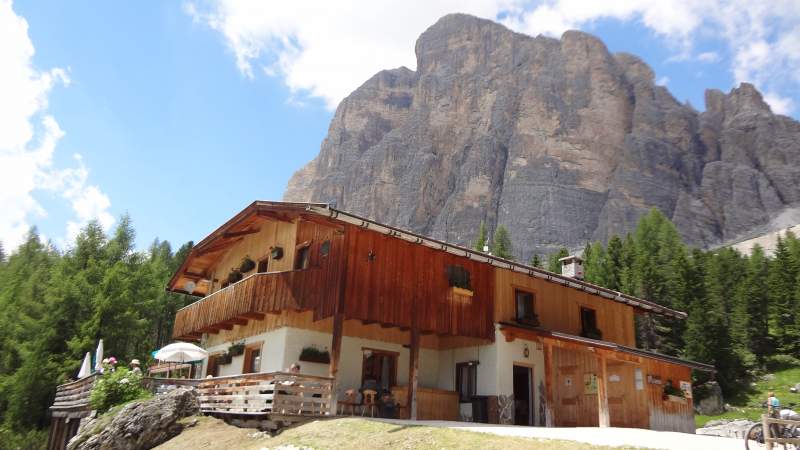
From the car parking at the Dibona hut, you follow the route that leads to Rifugio Giussani (the picture below) which is at the elevation of 2600 meters (8530 ft). This is the same direction for both routes.
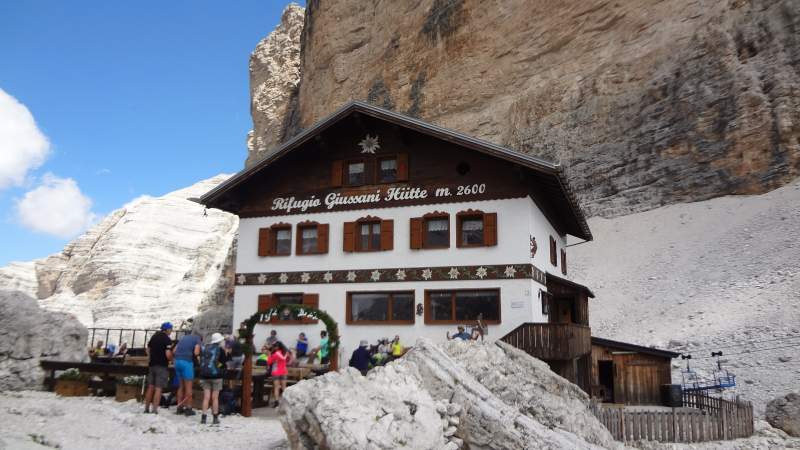
So if you want to stay the night in a hut and then to continue next morning to the summit, you can use any of these two huts. But note that there is an elevation difference of around 517 m (1696 ft), and trust me this is a lot.
The picture below shows the pass which should be your direction, this is above the Dibona hut and the route zig-zags in the direction of the Giussani hut. I took the picture when descending.
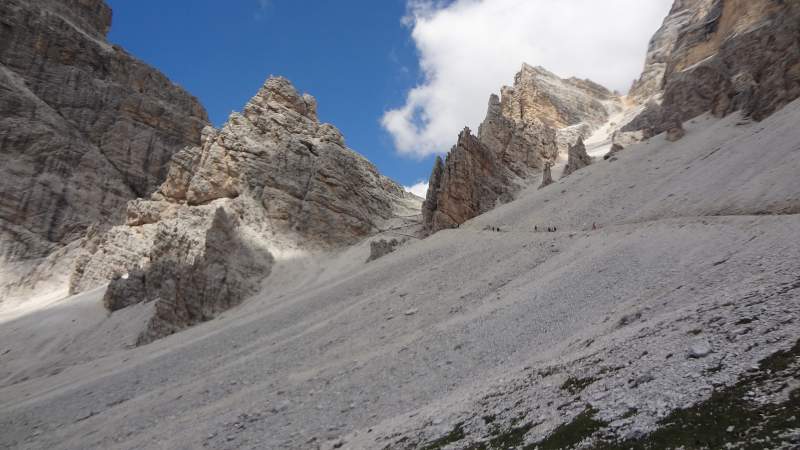
Note that there are also some other possible start points from the south-west direction, you can find them easily in the map mentioned above.
1. The first route is the Giovanni Lipella via Ferrata
I did not go that way so cannot say much about it. Here in the site, I only describe the routes that I climbed myself, so that I can provide a reliable first-hand information.
The reason for not going that way was that I was not sure about possible snow in narrow gullies and on galleries. One dangerous passage can ruin the day, you can read about such an experience in my text about Jof Fuart.
But you can get some feeling from this great video below. You will see two young people who were climbing it a few days before my own climb.
You will also see that they had to give up just below the summit because of rain and lighting concerns. At this point, they did not need more than 25 minutes or so. I must say, I admire the fact that they were so rational, it may be very hard to give up when you are so close.
2. The second is the normal walk-up route from the Giussani hut or from the car parking
So from the Dibona hut go in the direction of the Giussani hut. The direction should be obvious and visible from the car parking.
At the Giussani hut, when you are alone in the morning, it can be easy to miss the direction. I did this mistake, and have seen some other people doing the same later when I descending the summit.
Namely, I went up in the picture shown below. The reason is that there is some path visible in the scree, but when you get there you will find yourself on ledges and realize that this is not the route. What you have to do is to go diagonally in the west direction.
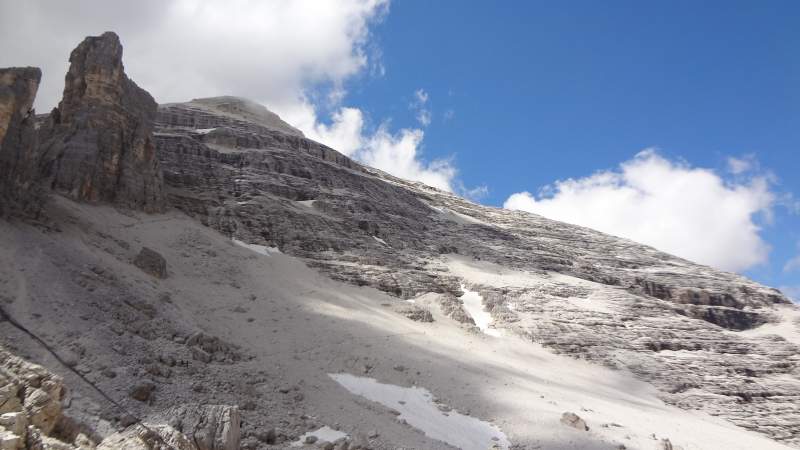
Later during the day, you will see a long line of people going up and the direction may look obvious, but trust me this is not so in the early morning.
So you will approach the summit ridge from the north-west side. This is just the opposite to the direction of Dibona hut, which means you have made a half-circle loop around the mountain. At one point, you will come to the place on the ridge where the previously mentioned ferrata route joins your route.
My climb
I slept in the car on the parking, have seen several other people doing the same. At 5:05 AM, I was on my way up and arrived at the Giussani hut at 6:35 AM. Did not stop there and just continued.
At some point, as mentioned above, I lost the route and spent some time trying to get back and to find the route. So eventually all was fine and I was on the summit at 9:35 AM.
All in all, this was in 4 hours and 30 minutes, not so bad for the first mountain in the season. But do not ask me about my muscles the day later. There were only two people on the summit, a father and a son, who passed me at some point below on the route.
The weather was perfect, but this was so only in the morning. When I saw the north-west summit ridge in front of me, I knew this will be a successful day, see what I have seen:
Note that below the summit, the third photo above, you can choose to follow the ridge or you can go to the right and approach the summit in an anti-clockwise loop. I chose the latter, but it was a bit icy in the early morning and cold. It is better to follow that beautiful ridge, you might be in the sun all the time.
On the summit, I had a period of clear views around, see the other two peaks from the Tofane group:

I had my morning coffee on the summit, I carry my MSR Pocket Rocket stove and a sports-copy of a Bialetti pot, and enjoyed for half an hour or so before some other people started arriving.
But at some point clouds came. Here is one moment I captured just as I was about to go back. It was not warm on the summit at all, but as you see some would disagree:
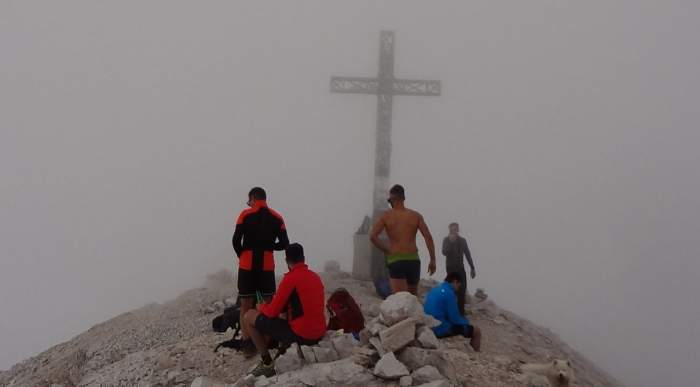
On the way back, the weather improved, see some details in the pictures below. The first picture shows the place where the ferrata route (coming from the left in the picture) joins the other normal route, this is at around 3027 m (9931 ft) of elevation.
Equipment, supplies & accommodation
The normal route I followed requires no special equipment. But this is not so for the mentioned Lipella route. So you can use any hiking boots, it is always best to have a good ankle support.
I had my Salomon Quest Prime GTX boots, and I used the Osprey Stratos 24 pack which is perfect for such a day tour. I always carry all waterproof layers, plus gloves. I can tell you, I needed it two days later on my climb of Piz Boè.
I also use a pair of trekking poles, on this occasion I had a pair of Komperdell poles, but this is up to you. It can be hard without sunglasses, so make sure you have them with you, plus a hat, and some sunscreen.
There is no running water around in summer months, so carry it unless you want to buy at the Giussani hut. I had two liters and this was enough.
The same holds for the food. You can have everything in the two huts, otherwise carry it in a daypack.
Orientation should never be a problem, except for the small episode mentioned previously.
Accommodation: This is a popular area but there are many options to rent an apartment or you can choose any of the camping spots around.
Final thoughts
So this was my report of climbing Tofana di Rozes, this is a beautiful place, and it is not surprising that it is so incredibly popular. Technically, the route I followed is a walk-up type without exposed sections.
But this is a high mountain and you will feel the altitude. The oxygen concentration at its summit is around 14% as compared to 20.9% at the sea level. So this is a reduction to around 62% of its normal see level value. Note that you can also make a round tour if you do not wish to go to the summit, or if weather is not on your side.
On my way back I met tens and tens of people going up, and I was surprised with how inappropriately some of them were dressed. Also, they were going up when it is normally the time to get off the mountain.
These are some of the reasons for tragedies that sometimes happen. Just one day later, there was one huge, on the nearby Marmolada mountain, I wrote a short text about it, you can read it here. You might want also to read my report from climbing Piz Boè which is not far from this place.
So I stop here, thank you for reading. You might want to read also my text about Sasso Piatto which is in the same area.
Please join us at our Facebook group Dolomites Visitors Hub. Let me know if you have questions or comments, there is a comment box below.
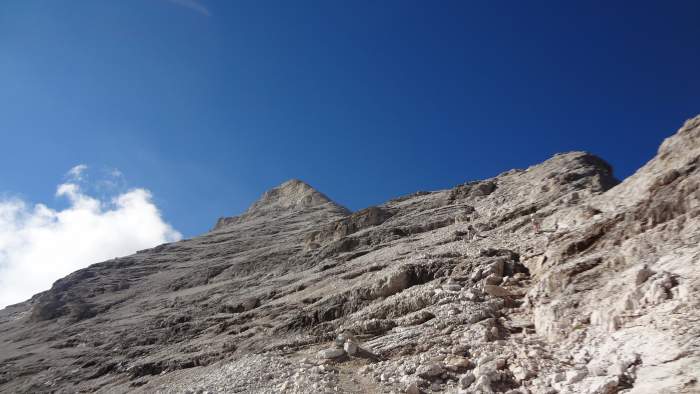
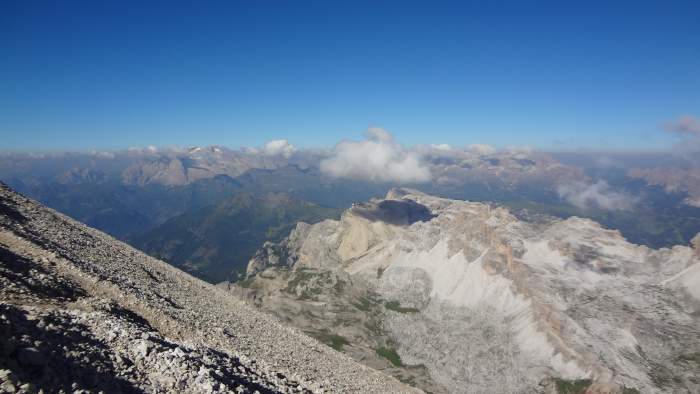
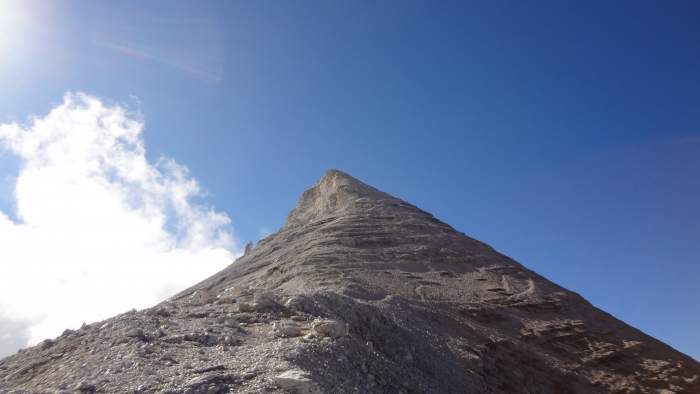
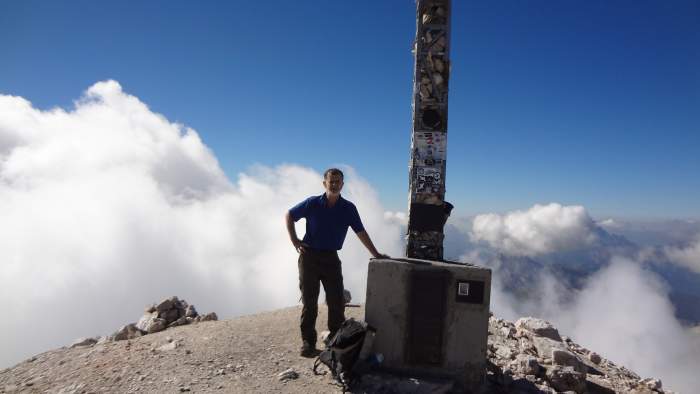
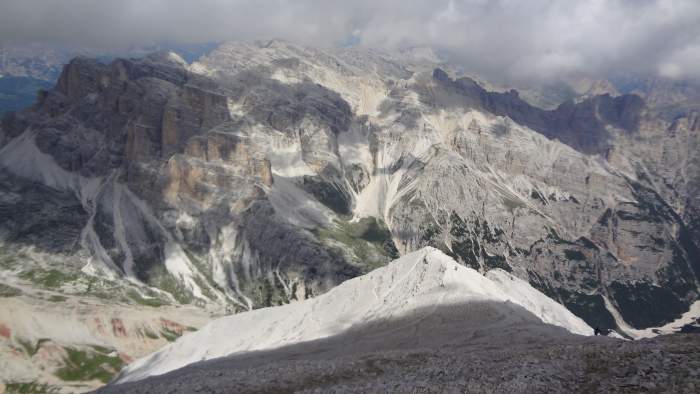
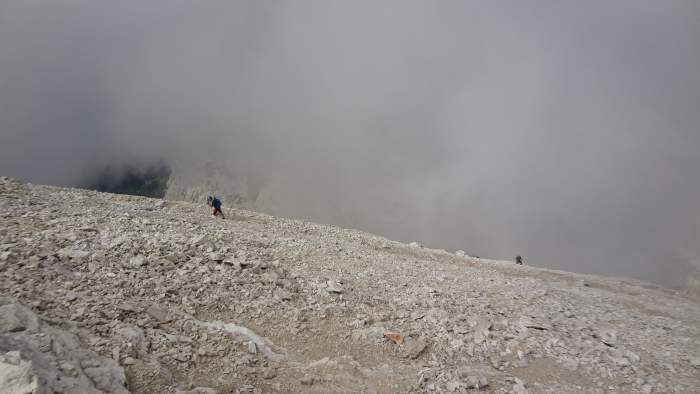
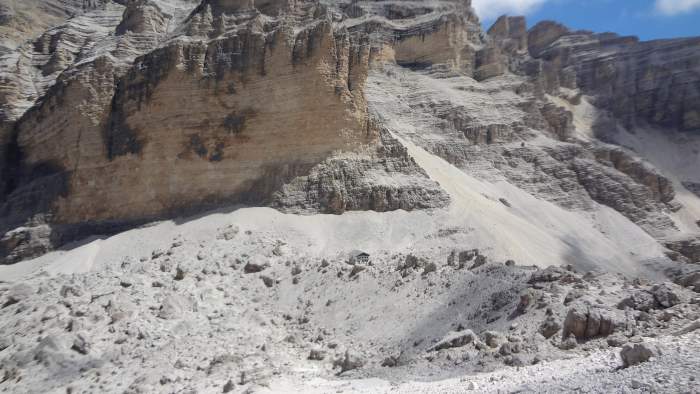
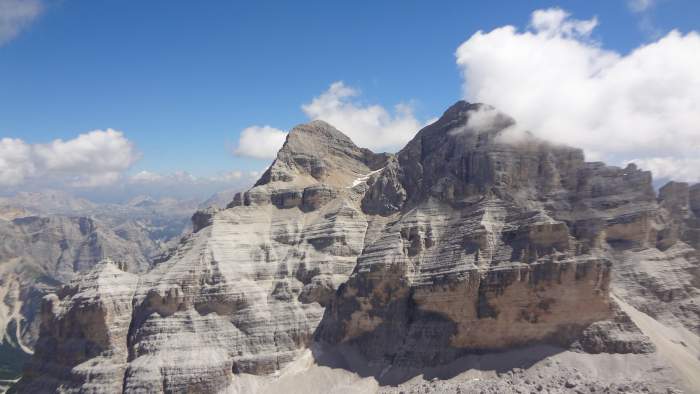
gary says
Another great report well done,i think a seed has been planted…again 🙂
Jovo says
Thank you Gary, this is a really great summit, I was enjoying watching it from several different mountains and passes around after my climb.